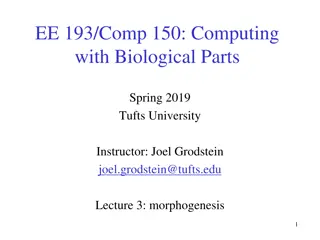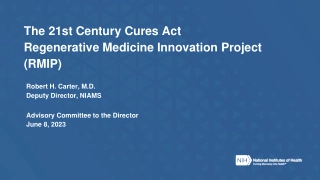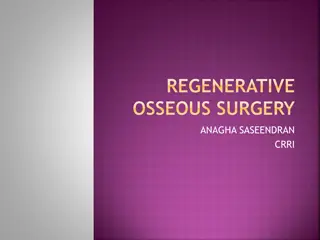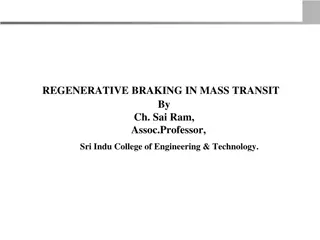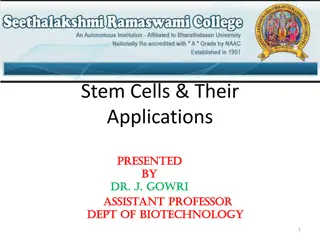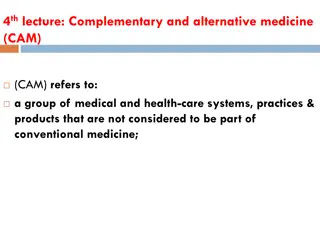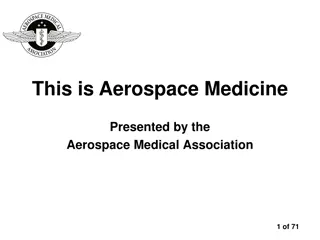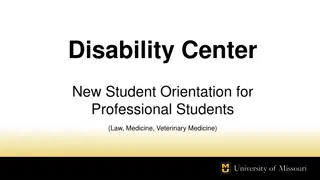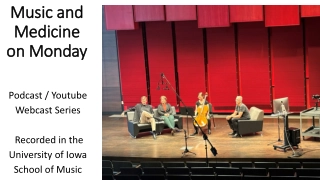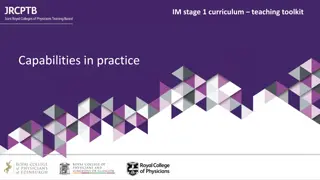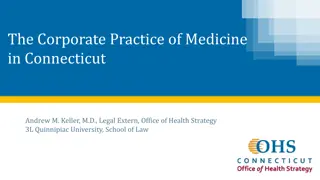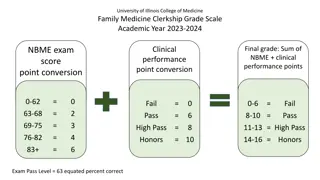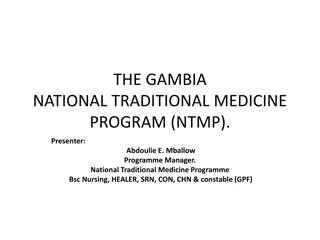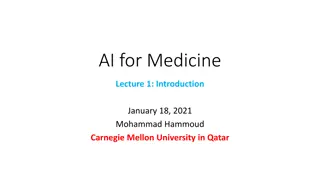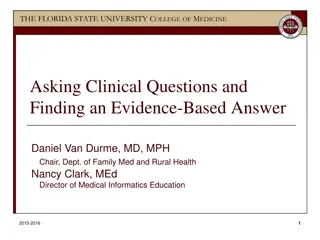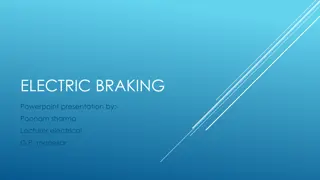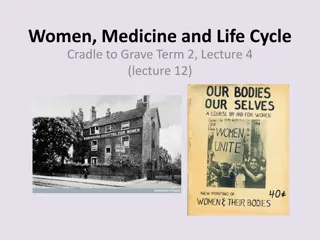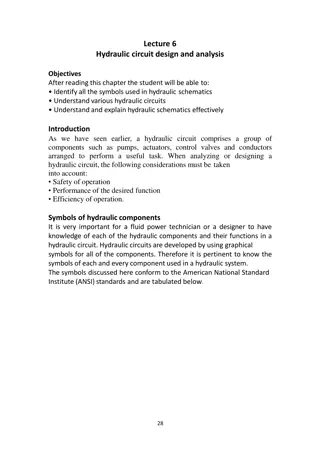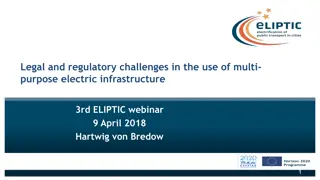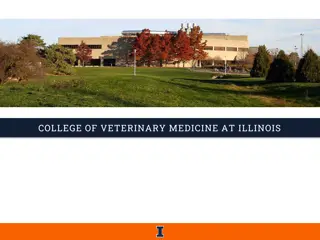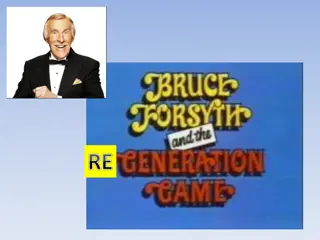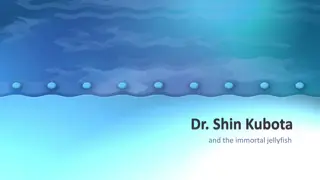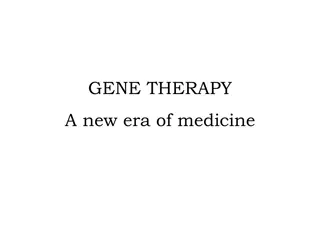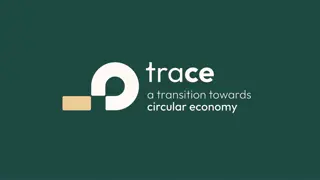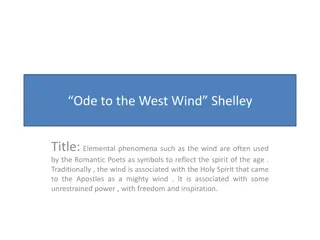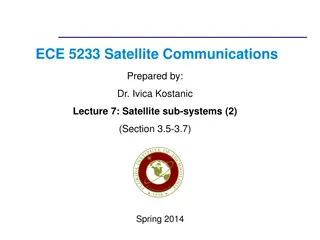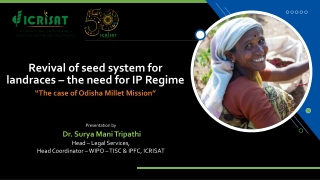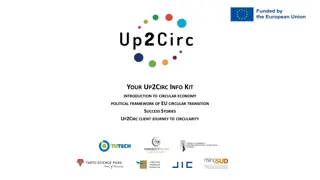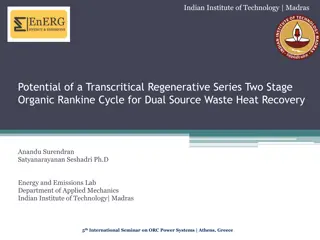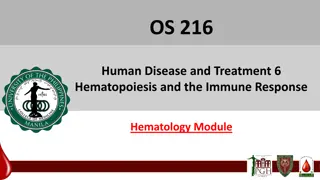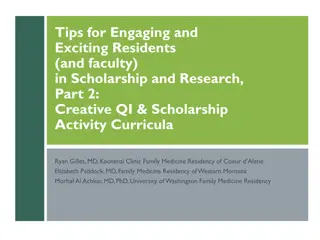Exploring Bioelectricity and Regenerative Medicine in Morphogenesis
Delve into the fascinating world of bioelectricity, regenerative medicine, and morphogenesis as discussed by Joel Grodstein in EE.123 at Tufts University. Discover the origins of bioelectricity, its relevance in neuronal functions, cardiac bioelectricity, and its role in morphogenesis. Explore the potential of regenerative medicine in treating various diseases through organ transplants and stimulating organ regrowth. Uncover the mysteries of morphogenesis by studying organisms like planaria and tadpoles capable of regenerating organs, and ponder the algorithms and bioelectrical mechanisms at play in these processes.
Download Presentation

Please find below an Image/Link to download the presentation.
The content on the website is provided AS IS for your information and personal use only. It may not be sold, licensed, or shared on other websites without obtaining consent from the author. Download presentation by click this link. If you encounter any issues during the download, it is possible that the publisher has removed the file from their server.
E N D
Presentation Transcript
EE 123 Bioelectricity Tufts University Instructor: Joel Grodstein joel.grodstein@tufts.edu Lecture 4b: morphogenesis 1
Big picture of the course Where does bioelectricity come from? Neurons and working with the nervous system Cardiac bioelectricity Worms Bio backgrounder Morphogenesis Building a worm Vmem pattern 2 EE 123 Joel Grodstein
We said that cells express proteins based on chemicals in their environment. Do you think the stripes will eventually go away? From Speedbump, by Dave Coverly 3 Bioelectricity Joel Grodstein
Regenerative medicine Various diseases are best treated with organ transplants Kidney transplants for diabetes Liver (cirrhosis, hepatitis) Heart (various heart diseases) Organ transplants have problems Typically far more requestors than available organs Rejection is a constant problem A lifetime of immune-suppressant drugs is no picnic Is there a better way? Regenerative medicine 4 Bioelectricity Joel Grodstein
Regenerative medicine Not quite ready for prime time yet Hope #1: stimulate the body to regrow its own organs adult humans don t really do that Hope #2 Start with induced pluripotent stem cells and grow organs in vitro Precisely controlling every detail of growing a kidney in a lab seems impossible We need a high-level API 5 Bioelectricity Joel Grodstein
The Big Picture Morphogenesis is a big cool mystery If we understand it, we may understand regenerative medicine Observations planaria and tadpoles can regrow organs what can we learn from them? Our plan for morphogenesis Look at the weird, wonderful things that animals can do Hypothesize: what algorithms are they using? Might it be bioelectrical? 6 Bioelectricity Joel Grodstein
Why is morphogenesis hard? If babies can do it, how hard can it be? Hydra 20K 1000 Human 30K 100 billion Genes Neurons The game of evolution is not so much about inventing new proteins, but rather about assembling the same ones in new ways (Rafael Yuste) DNA just creates protein, not (directly) body shape Similar DNA sequences encode very differently-shaped animals No clue how to look at a genome and predict animal shape Or to determine which DNA sequence will create an arbitrary shape Is there a higher-level interpretation somewhere? A string of 3 billion DNA bases is daunting A high-level API would be really nice! 7 Bioelectricity Joel Grodstein
Hypothesis #1 Maybe the DNA is just a set of (very intricate) instructions Like building Legoland from 37T Legos! Twins When an embryo splits into twins, each twin grows perfectly Do you think that identical twins have identical fingerprints? Running the same set of instructions should produce the same results We ll look at some data & then revisit this hypothesis 8 Bioelectricity Joel Grodstein
Picasso tadpoles Inject one cell of a two-celled embryo with Vmem-disturbing mRNA one-sided growth defects Defects largely correct themselves over 170 days mRNA is diluted as cells multiply Eye location corrects, though eye functionality does not Are twins and Picasso tadpoles consistent with hypothesis #1? Take 5-10 minutes, check out Wiki Albert Ebeneezer Fox if you like Credit: Normalized Shape and Location of Perturbed Craniofacial Structures in the Xenopus Tadpole Reveal an Innate Ability to Achieve Correct Morphology, Dev.Dynamics 2012 9 Bioelectricity Joel Grodstein
Hypothesis #2 DNA doesn t specify an exact sequence of instructions Life is hard! In the nanoworld, everything is dancing (Philip Nelson) Biology at the cell level is a noisy, statistical business Somehow we develop body shape very reliably Instead DNA (somehow) specifies a target shape A machine compares current vs. target and keeps adjusting Really useful in our noisy, dangerous world! Does this explain the Picasso tadpole? Seems to Next question: what form are the inputs to this machine? I.e. what data structures are we using? 10 Bioelectricity Joel Grodstein
Electric tadpoles We ve shown robustness in growth Next: argue that bioelectricity is involved Measured Vmem on a developing tadpole embryo to get a map. Future eyes correspond to hyperpolarized Vmem Inject chemicals to disrupt Vmem at future eyes deformed eyes Inject chemicals to alter Vmem at unrelated locations ectopic eye (blue arrow). And green arrow = normal eye The ectopic eye only happens if they hit the right Vmem. Doesn t matter which chemical they use, or which ion channel they disrupt, as long as they hit the Vmem depolarized hyperpolarized Credit: Transmembrane voltage potential controls embryonic eye patterning in Xenopus laevis, Development 2012 11 Bioelectricity Joel Grodstein
Yes, its the voltage Inject tadpole embryo with Notch ICD (depolarizes Vmem) later brain defects in 46%. Also inject with Kir6.1 mRNA (which further depolarizes Vmem) defects in 68% Pair Notch ICD with Kv1.5 or Bir10 mRNA (hyperpolarizers) defects are rescued! Arrow color key: Blue = malformed brain part Red, orange, yellow, green = locations of various correctly-formed brain parts Other data (omitted) shows that brains occur at a specific Vmem m alform ed B rains % Credit: Endogenous Gradients of Resting Potential Instructively Pattern Embryonic Neural Tissue via Notch Signaling and Regulation of Proliferation,J.Neuroscience 2015 12 Bioelectricity Joel Grodstein
Layers Is this evidence for a layered system? the tadpole builds a good brain or good eyes wherever Vmem tells it to This is exactly what we wanted! Short-cut some of the complexity The growing body acts as a layered piece of software The upper layer creates a pattern of Vmem The lower layer sees that pattern, and creates body shapes based on it Note that both layers are controlled by DNA, but it s still a layered system How convincing is this evidence? Create Vmem pattern API target current Differentiate cells following Vmem pattern growth directions compare 13 Bioelectricity Joel Grodstein
The amazing planaria World champion of regeneration The planaria is a flatworm It has a brain and can learn It has nerves (in green) Typically 3-15mm in length And more or less immortal Credit: Modeling Planarian Regeneration: A Primer for Reverse-engineering the worm, PLOS Comp Bio 2012 Bioelectricity Joel Grodstein 14
Adult planaria retain a large proportion of stem cells Cut one into n pieces (n 279) Every piece regenerates into an entire planarian The head-tail polarity is retained! While individual cells die, the planarian can regenerate itself (essentially) forever Individual planarian cells die after 1 month; worm as a whole seemingly lives forever Planarians reproduce primarily asexually - anchor their tails and pull themselves apart into front and back halves - then regrowing into two genetically-identical children Credit: Planarian regeneration as a model of anatomical homeostasis: recent progress, Semin Cell Dev Biol 2018 Bioelectricity Joel Grodstein 15
Chop it up most any way at all It regenerates, remembering which side its head was on Take a front 1/3 from one planarian and a rear 1/3 from another planarian and abut them Still works fine! Most planaria have a mish-mash of different genes Planaria retain/accumulate mutations forever Different cells may have different numbers of chromosomes and the planarian still functions correctly as an organism! Compare thatto any computer program you ve ever written Comparisons to human organ rejection? 16 Credit: Modeling Planarian Regeneration Bioelectricity Joel Grodstein
Electricity is involved again Polarity: head is +, tail is - What do you think will happen in this experiment? How about this? Two-headed worm! Is this more proof of a layered system? H H + H T H T Vmem T - 17 Bioelectricity Joel Grodstein Credit: Modeling Planarian Regeneration
Building the outer layer Planarian regeneration: more evidence that a Vmem pattern is the API Next question: how do we build the Vmem pattern? We used batteries & needles to build Vmem, but how might nature do it? Rough first cut now; next slide set is an experiment+lab Create Vmem pattern API target current compare growth directions 18 Bioelectricity Joel Grodstein
Weirdness alert What part of your body does most of your thinking? Brains are very good at pattern recognition common sense says the brain is highly involved in pattern creation and checking does anyone see a chicken/egg problem here? 19 Bioelectricity Joel Grodstein
Primitive cognition Neurons & brain play a part in growth, regeneration. But this must work in an embryo without much of a brain yet! And in planaria whose head has been cut off! How could this be? Hypothesis the cells themselves act as a sort of brain One that has no actual neurons! Is this feasible? The basic machinery of ion channels, GJs and bioelectricity came earlier in evolution than did neurons Single-celled organisms communicated via neurotransmitters Neurons merely made Vmem fast enough for real-time muscle control Questions: is primitive cognition powerful enough to build a Vmem pattern? to implement the compare/fix machine? 20 Bioelectricity Joel Grodstein
Gap junctions and neurons Morphogenesis is a marvel of distributed computing Clearly that implies cells must talk to each other! How? Via neurons & the brain Via gap junctions (GJs), like the heart GJ: a little tube that connects two nearby cells Molecules can travel between the two cells Think wires between gates If a GJ connects two cells with different Vmem, then negative ions move towards the + cell +10mV Na+ Cl- Na+ -20mV Cl- 21 Bioelectricity Joel Grodstein
+10mV Na+ Cl- We ve talked about GJ being a resistor GGJ IGJ Na+ -20mV Cl- Vmem GGJ GGJ really looks more like this Can you draw IGJ? Anything really weird about it? Negative resistance! Vmem 22 Bioelectricity Joel Grodstein
Cell #1, V1 Lots of feedback between the electrical and chemical networks Cell voltage can turn on/off GJs, which pass ions Ions can change Vmem directly, or by control ion channels, which control voltage; or can activate TFs The feedback has gain Bottom line: we have the material to build a bioelectrical computer Cell #2, V2 23 Bioelectricity Joel Grodstein
Block GJs occasionally get a 2H worm Block GJs and neurons really weird results Conclusions about how Vmem patterns are formed? GJs and neurons both working together somehow Proof of concept for regenerative medicine we are using a high-level API to control what grows We have a sensible theory Time to look at more weird science 24 Credit: Modeling Planarian Regeneration Bioelectricity Joel Grodstein
The amazing planaria: head shape Procedure: Start with Girardia dorotocephala, a particular planarian species Cut off head and tail; preserve the trunk Dunk in octanol (blocks GJs) 3 days Regenerate 7 days in water Results: The worm regrows with a new head shape The head always resembles some planarian species never a new shape Probabilistic head-shape distribution; frequency mirrors evolutionary distance to the original species After several weeks: head reverts back to its original shape in a second repatterning! Bioelectricity Joel Grodstein Credit: Gap junctional blockade stochastically induces different species-specific head anatomies in genetically wild-type Girardia dorotocephala flatworms, 2018 25
Theories? Maybe your DNA remembers evolutionarily- earlier versions of shape? Maybe the machine can get stuck in local minimum kind of things? Lots of human-engineered machines should go from A C but get stuck at B Like simulated annealing and other optimation algorithms 26 Bioelectricity Joel Grodstein
The miracle of Bambi Male deer shed and regenerate their antlers every year Antler shape changes slightly every year until maturity Becomes more complex After maturity, the shape is fixed 27 Bioelectricity Joel Grodstein
except injury to left antler, year 6 left right Normal mature antler shape (fixed) year 6 7 8 Injured shape persists two years Shape change sort of propagates to uninjured right antler! Not shown: antlers will eventually return to their normal shape Credit: A linear-encoding model explains the variability of the target morphology in regeneration, Interface, 2014 28 Bioelectricity Joel Grodstein
Where is the deer hiding its memory? Even though the antlers are completely lost every year, the memory of the new shape persists Harry Potter and the Chamber of Secrets Ginny! said Mr. Weasley, flabbergasted. Haven t I taught you anything? What have I always told you? Never trust anything that can think for itself if you can t see where it keeps its brain? Where is the memory of the new shape held? Clearly somewhere outside of the antlers themselves Not in any DNA (no reason to suspect DNA mutation) Do we really believe that a pixel-by-pixel image of the antlers is stored somewhere in the deer s body? Somebody should tell Mr. Weasley about primitive cognition 29 Bioelectricity Joel Grodstein
More weird stories: crabs A normal fiddler crab has no inherent asymmetry Cut off either one of its front crusher legs during growth (accidents happen in nature) It keeps growing until normal sized but its partner gets huge! Now cut off both front crushers. What happens? a The first amputation is remembered! Credit: A linear-encoding model explains the variability of the target morphology in regeneration, Interface, 2014 30 Bioelectricity Joel Grodstein
More amazing planaria feats Not all memory is stored in the brain Experiment, part 1 Feed planaria on a textured surface Remove for two weeks They now feed on a textured surface quicker than untrained planaria Conclusion: long-term memory is possible. Long enough to regrow! Experiment, part 2 cut off their heads, regrow (14 days) Will they still retain their training? No? Memories are stored in your brain If you regrow a new one, they re gone Yes? Morphogenesis clearly create neurons. Human newborns can cry, suckle, etc. Credit: An automated training paradigm reveals long-term memory in planarians and its persistence through head regeneration, 2013 31 Bioelectricity Joel Grodstein
Theories? How is the target state stored? Partly in Vmem patterns rewritable, redundant/nonlocal DNA tends to snap it to one of a small number of reasonable goals stored in DNA Redundant storage is used in all computers (ECC, chipkill) 32 Bioelectricity Joel Grodstein
Layered systems are awesome Engineers build layered HW/SW systems frequently They re often quite complex! But way simpler than one big system We can manipulate shape without understanding the lower layer We just need the API which we re saying is the Vmem pattern Vmem is an instructive signal; it tells the lower layer what to do The lower layer doesn t care how we make a Vmem pattern Abstraction is a powerful tool Create Vmem pattern API target current compare growth directions 33 Bioelectricity Joel Grodstein
Background material https://vimeo.com/184365295 Very nice overview and introduction, from talk at the Wyss institute 2016 https://allencenter.tufts.edu/ More background and context https://allencenter.tufts.edu/our-research/publications/ Full bibliography, and lots more reading 34 Bioelectricity Joel Grodstein
More progress They induced leg regrowth in an adult frog by imposing an embryonic Vmem pattern and then letting it sit for 7 weeks. Original work: they found a drug cocktail that affected Vmem and induced regrowth of an amputated tail Then the same cocktail also worked for leg regrowth The cocktail is really a rebuild whatever usually goes here recipe Credit: Cracking the bioelectric code: probing endogenous ionic controls of pattern formulation, 2013 35 Bioelectricity Joel Grodstein
Where do we go from here? Next up: dig into a planarian Vmem hypothesis Understand & program a way it might build a Vmem pattern to distinguish head from tail 36 Bioelectricity Joel Grodstein
Debate Take some time to think about: What animal facts does our model explain? What doesn t it explain? 37 Bioelectricity Joel Grodstein
BACKUP 38 Bioelectricity Joel Grodstein
More amazing planaria feats Why is this experiment interesting? Currently neurons in the human CNS do not regrow. But what if, e.g., stem-cell treatments can regrow neurons for humans with neurological disease? What connections will they have? More evidence that bioelectrical patterns are stored throughout the body and can have wide-ranging effects on regrowth Does this help to explain the moose & crab data? Credit: An automated training paradigm reveals long-term memory in planarians and its persistence through head regeneration, 2013 39 Bioelectricity Joel Grodstein
Layers The growing body acts as a layered piece of software. The upper layer creates a pattern of Vmem. The lower layer sees that pattern, and creates body shapes based on it. Note that both layers are controlled by DNA, but it s still a layered system. Neural networks are part of one or both layers In the upper layer, could decide what to build In the lower layer, could implement current state vs. desired state what to do next Lower layer also outputs All done signal Create Vmem pattern API target current Differentiate cells following Vmem pattern growth directions compare 40 Bioelectricity Joel Grodstein
Layers Answer to how do we build the Vmempattern? Can we drill down into these two black boxes? How might these machines be built? What computations could they be implementing? Hint we haven t talked about neural networks yet Create Vmem pattern pattern with GJs Create Vmem API target current compare growth directions 41 Bioelectricity Joel Grodstein
What does this explain? The repeated observation (tadpoles, planaria) that we can control shape by controlling Vmem Reimplementation of the same shape repeatedly (deer, crab, Emmons-Bell) The top level is picking the shape (and remember last year s shape, even if it s wrong ). The lower level is implementing that shape, over and over. Some specific Vmem patterns (planarian head-tail reversal) 42 Bioelectricity Joel Grodstein
What does this not explain? Where the shape is stored in the deer & crab Why it regenerates after a few years. Most of the implementation details and speaking of which 43 Bioelectricity Joel Grodstein
Hypothesis #1, again What if: There is an explicit set of growth rules stored in the DNA The injuries during growth change the growth rules, leading to a new end result When we regrow again, the changed rules then merely produce the same result over and over again Is that reasonable? Physical injuries do not really mutate DNA; they just mechanically break (e.g.,) bones It is not reasonable to believe that, in future years, a little machine inside the organism somehow breaks their crushers again, at just the right time, the newly-correct shape So let s look at another piece of data 44 Bioelectricity Joel Grodstein
Why are good theories hard to find? Why is it hard to come up with good theories? you can t hit what you can t see it s hard to explain what you can t dissect Classic technique in biology: kill a specimen examine it under a microscope Doesn t work for bioelectricity Consider a bioelectric memory cell Can store either a 0 or a 1 The basic parts of the cell are identical either way The only difference is the electricity, which you don t see under a microscope Measurement techniques are improving but need much more improvement still killing a cell destroys its bioelectrical state 45 Bioelectricity Joel Grodstein
Divide and conquer GJs allow cells to communicate when needed to decide where your eyes are and where your nose is Once that s done, we can turn off some GJs thus create smaller, independent subnetworks now decide where your retina is vs. your iris and septum vs. nose hair I.e., solve a huge problem by divide and conquer. 46 Bioelectricity Joel Grodstein
Cell #1, V1 There are feedbacks between the electrical and chemical networks Cell voltage can turn on/off GJs, which pass ions Ions can control ion channels, which control voltage; or can activate TFs The feedback system can create patterns of ions and V very like reaction-diffusion called gating-electrodiffusion See The Chemical Basis of Morphogenesis, Alan Turing 1952 Or Wikipedia Cell #2, V2 47 Bioelectricity Joel Grodstein
Hypothesis #3 Morphogenesis is a multi-step process Step 1: DNA specifies a target shape that is then (at least in deer) stored elsewhere Step 2: regeneration aims for the stored shape but what is that format? Suggestion: a pattern of Vmem Step 4: occasionally the stored shape gets refreshed from DNA in deer For the technically minded, step #3 is called an inverse problem inverse problems are hard unless the function is simple (i.e., easy to invert) 48 Bioelectricity Joel Grodstein
A hypothesis The planaria is a remarkable animal It is well studied We have a lots of data But we don t have any proven theory for how it works! Are we ready to put together some ideas? hopes? hypotheses? 49 Bioelectricity Joel Grodstein
BACKUP Image processing Deep artificial neural networks (ANN) usually process images in layers Each layer works at a slightly higher level 50 Credit: The bioelectric code (Justin Guay) Bioelectricity Joel Grodstein


